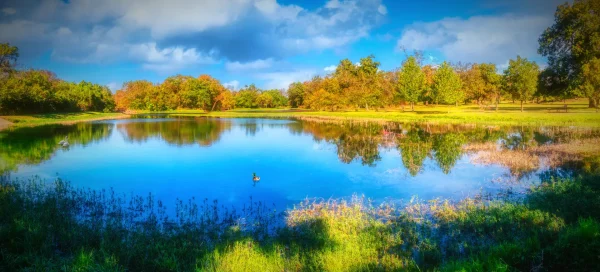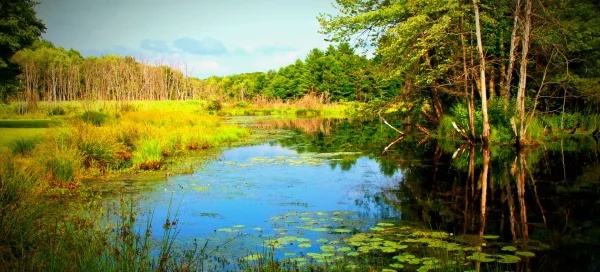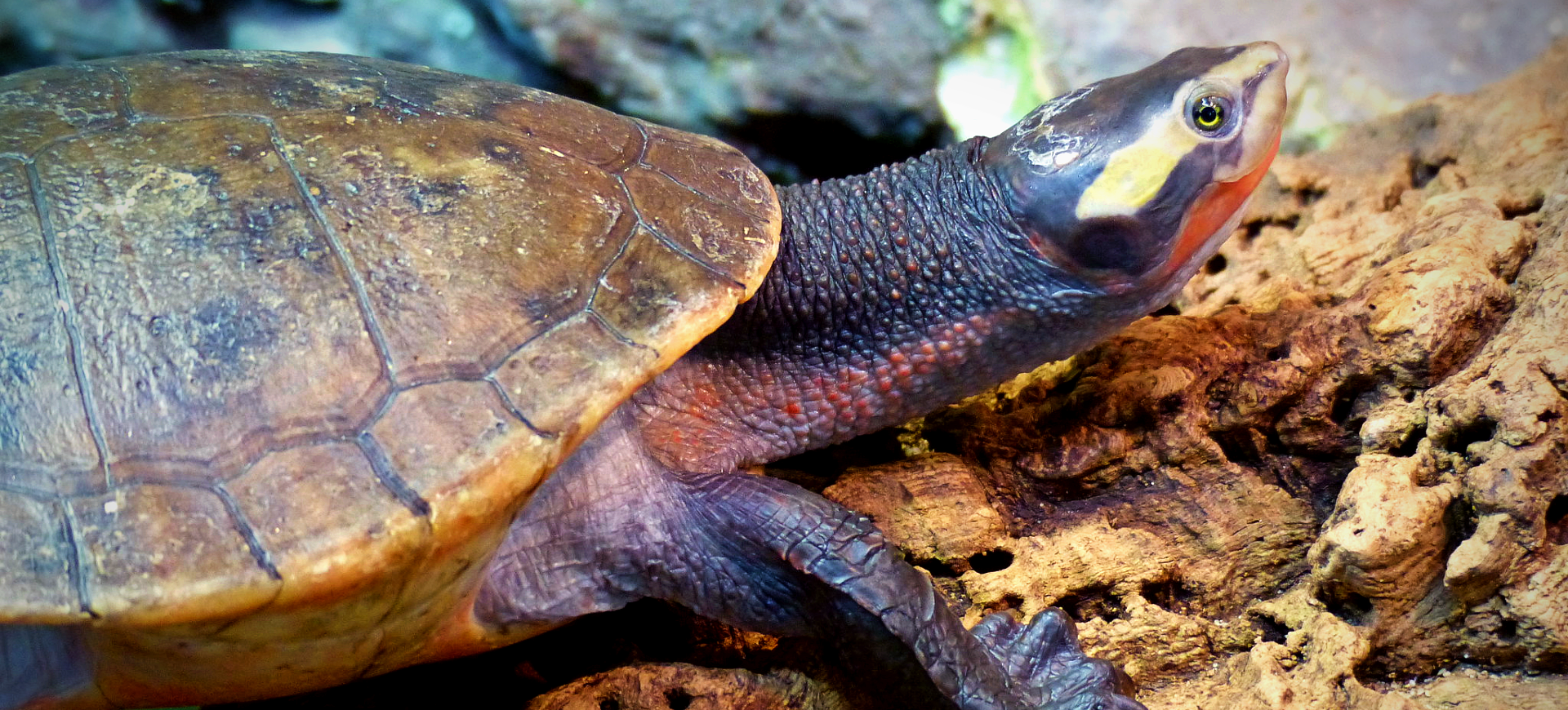Overview
The New Guinea Snapping Turtle, also known as Elseya novaeguineae, is a distinctive species of turtle native to the fresh waters of New Guinea. It is particularly noted for its strong jaws and aggressive demeanor when threatened. This species belongs to the family Chelidae, known for its long necks and unique head-tucking behavior. It is primarily aquatic but is also known to bask on logs or rocks near water bodies.
This turtle possesses a rugged, dark brown to black carapace with a length that can vary significantly among individuals. Juveniles display more vivid and contrasting colors compared to adults. The New Guinea Snapping Turtle is a nocturnal creature, spending most of the daylight hours hidden in the seclusion of the water and becoming more active at night.
Given their elusive nature and preference for murky water habitats, there is still much to learn about the behavior and ecology of the New Guinea Snapping Turtle. Their diet primarily consists of aquatic plants and small animals, indicating a role in controlling the population of certain species in their ecosystem. They are also crucial in maintaining the health of their aquatic habitats.
Taxonomy
Kingdom
Phylum
Class
Order
Family
Genus
Species
Type
Gallery
Physical Description:
The New Guinea Snapping Turtle has a robust, oval-shaped carapace deeply serrated at the rear. The carapace color ranges from dark brown to almost black, often featuring a rough texture. The plastron (the turtle’s underside) is generally lighter, ranging from cream to yellow. The skin on its legs, neck, and head is typically grey or brown, with some individuals exhibiting lighter patches.
Adults exhibit sexual dimorphism, with females generally being larger than males. This species’ head is notably large and muscular, with powerful jaws used for snapping. They have webbed feet suited for their aquatic lifestyle and long, strong claws. Their eyes are positioned high on their heads, allowing them to see above water while remaining mostly submerged.

Lifespan: Wild: ~30 Years || Captivity: ~40 Years

Weight: Male: 58-62 lbs (26-28 kg) || Female: 62-66 lbs (28-30 kg)

Length: Male: 9.8-11.8 inches (25 - 30 cm) || Female: 11.8-17.7 inches (30 - 45 cm)
Characteristic:
Native Habitat:
The New Guinea Snapping Turtle is found in various freshwater habitats across New Guinea. They favor slow-moving rivers, lakes, and swamps, often with muddy bottoms and abundant vegetation. Their preference for murky waters provides ample hiding spots from predators and prey alike.
These turtles are well-adapted to their aquatic environments, with physical features that aid in swimming and diving. They can also traverse land, especially during the rainy season when they may move between water bodies. The specific habitat requirements of the New Guinea Snapping Turtle, such as water temperature and quality, play a crucial role in their life cycle and reproductive success.
Climate Zones:
Biomes:
Biogeographical Realms:
Continents:
Countries:
Diet:
Diet & Feeding Habits:
The New Guinea Snapping Turtle is omnivorous, eating plant and animal matter. In the wild, it consumes aquatic vegetation, fallen fruits, insects, mollusks, and small fish. Its powerful jaws allow it to crush hard-shelled prey like snails and crustaceans.
Juveniles tend to have a more carnivorous diet, gradually becoming more herbivorous as they mature. This dietary shift plays a role in their growth and development. In captivity, their diet can be supplemented with turtle pellets, leafy greens, and occasional protein sources. The feeding habits of these turtles reflect their role in controlling aquatic prey populations and dispersing plant seeds.
Mating Behavior:
Mating Description:
The mating behavior of the New Guinea Snapping Turtle is not extensively documented, but it is believed to follow patterns similar to other freshwater turtles. Mating typically occurs in water, where males pursue and court females. Male turtles may display aggressive behavior towards each other when competing for a mate.
The breeding season is thought to coincide with the rainy season, providing optimal conditions for egg laying and hatching. Females lay eggs in nests dug on sandy or muddy banks. The number of eggs and the exact timing of breeding can vary based on environmental factors.
Reproduction Season:
Birth Type:
Pregnancy Duration:
Female Name:
Male Name:
Baby Name:
Social Structure Description:
The social structure of the New Guinea Snapping Turtle is not well understood due to the lack of detailed behavioral studies. However, like many freshwater turtles, they are generally solitary and come together mainly for mating. They exhibit territorial behavior, especially males during the breeding season.
Juveniles are more vulnerable and may exhibit different social behaviors compared to adults. In captivity, these turtles can show aggression towards each other, indicating a need for space and territoriality. Understanding their social interactions in the wild requires more in-depth research.
Groups:
Conservation Status:
Population Trend:
The population size and dynamics of the New Guinea Snapping Turtle are not well understood. Due to the turtle’s elusive nature and preference for murky waters, population surveys are challenging. However, they are considered to be relatively common within their range.
Despite their presumed common status, like many freshwater turtles, they face habitat loss and degradation threats. The impact of these threats on their population is not fully quantified, but ongoing environmental changes could have future implications. Conservation efforts and more detailed population studies are needed to better understand and protect this species.
Population Threats:
Habitat loss and degradation are the primary threats facing the New Guinea Snapping Turtle. This includes the destruction of wetlands, pollution of water bodies, and sedimentation of rivers and lakes. These changes can directly impact their survival, affecting their food sources and breeding grounds.
Additionally, there is concern about the impact of climate change, as altered rainfall patterns and temperatures could affect their reproductive cycles and habitat suitability. While not extensively documented, there is also a potential threat from the pet trade and local hunting. If not regulated, these activities can contribute to declining numbers.
Conservation Efforts:
Conservation efforts for the New Guinea Snapping Turtle are not well-documented, primarily due to the lack of comprehensive studies on the species. However, general conservation measures for freshwater habitats in New Guinea benefit this species. This includes protecting wetlands, controlling pollution, and sustainable management of water resources.
Environmental education and awareness programs can also help conserve this species. By informing local communities about the importance of freshwater turtles and their habitats, harmful human activities can be reduced. International collaboration between Indonesia and Papua New Guinea could be crucial in ensuring the long-term survival of this species.
Additional Resources:
Fun Facts
- The New Guinea Snapping Turtle’s powerful jaws can snap with significant force, a defense mechanism against predators.
- They can stay submerged for extended periods, surfacing only occasionally for air.
- Juvenile turtles display more vibrant colors than adults, with patterns that fade as they age.
- This species plays a vital role in their ecosystem as predators and prey for larger animals.
- The serrated rear edge of their carapace is a distinctive feature not found in many other turtle species.
- They have a high tolerance for murky and low-oxygen water environments.
- Their eyes are positioned to allow them to see above water while remaining mostly submerged, an adaptation for both predation and defense.
- These turtles are associated with folklore and traditional beliefs in some local cultures.
- The New Guinea Snapping Turtle’s diet changes from primarily carnivorous to more herbivorous as it ages.
- Due to their secretive nature, many aspects of their life history and ecology remain a mystery to researchers.






